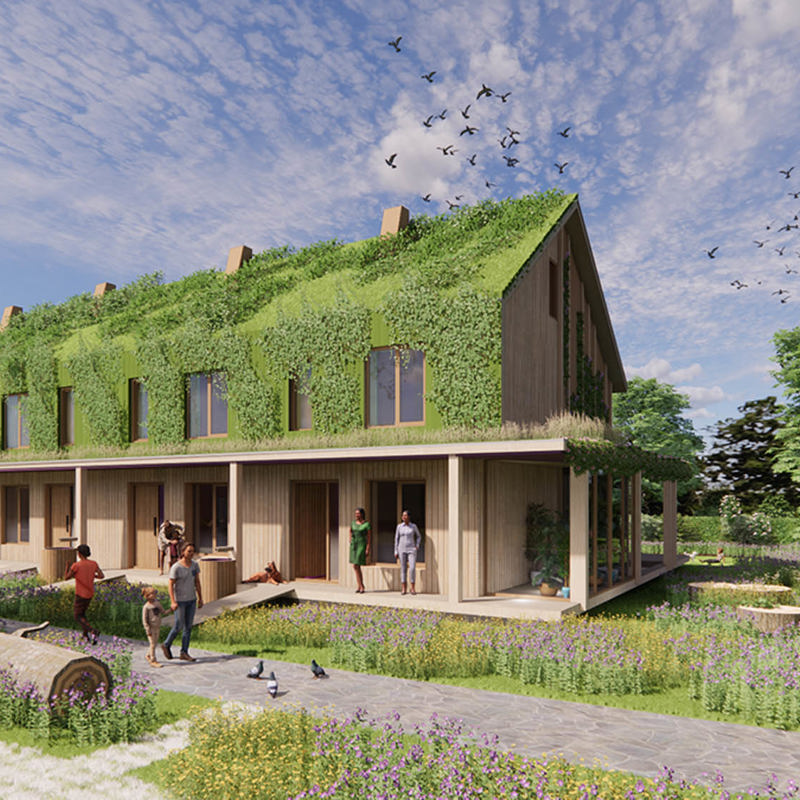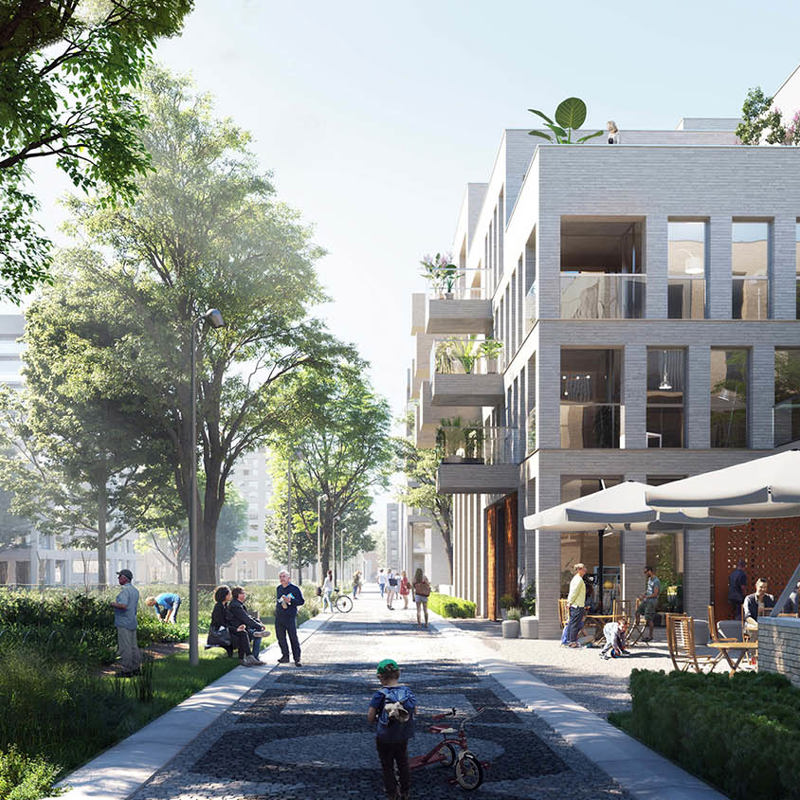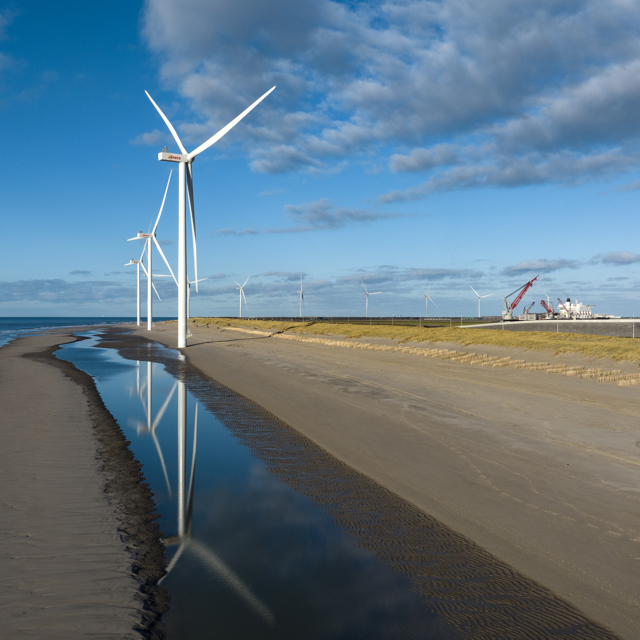"Only if you become sustainable, you will still play a role in the future"
Four years ago, Bramske van Beijma joined Ballast Nedam as Director of Corporate Social Responsibility and Digital Transformation & Innovation. Since then, the company has taken many steps in the area of sustainability, resulting in, among other things, a 42% reduction in CO2. What are the current opportunities and challenges? And how do these relate to the energy transition? A conversation about low-hanging fruit, energy independence and agreements with the chain.
Green power and battery packs
Within Ballast Nedam, multiple steps are being taken in many ways and at all levels. "We shouldn't use the phrase spreading like an oil slick, of course," says Bramske with a wink. "So let's put it this way: more and more people are picking up the gauntlet to make our company and our activities more sustainable. It's not a 'head office party'; the change is happening everywhere, in all corners and layers of the company." So what are some of the sustainability measures Ballast Nedam has taken? "We started with the low-hanging fruit, by purchasing green electricity for all our construction and office sites. But also for the production sites, such as our concrete plant. We also started investing in zero-emission construction equipment. With every investment of a new piece of equipment, a business case is drawn up to see whether a sustainable variant is financially feasible. In this way, we have already purchased several emission-free pieces of equipment such as an emission-free roller and a crawler crane."
Emission-free construction sites emit less CO2 and produce less noise, but a new problem arises. All that zero-emission equipment runs on electricity, which also has to come from somewhere. "That's why we recently invested in the purchase of three battery packs for the construction site." Speaking of electricity, another measure is replacing traditional, fossil-powered lease cars with electric models. Every new car is electric, so that Ballast Nedam will have a completely emission-free fleet by 2030.
Our goal: all our construction sites carbon neutral by 2030
Sustainability requires substantial investments. For that reason, Ballast Nedam seeks cooperation with suppliers in the chain. "For example, we made agreements with transport company De Bruyn in 2023," Bramske gives as an example. "In doing so, we commit ourselves to the multi-year use of electric transport equipment they purchase. This way we don't have to make the investment ourselves, but it is interesting for De Bruyn to do so. And it helps us in achieving our goal to have our transport and construction sites CO2 neutral by 2030." The collaboration is now bearing fruit. For example, a De Bruyn electric mixer combination, consisting of a Volvo FM Electric tractor with a 540 kWh battery pack and a mixer trailer with its own 60 kWh battery pack, was deployed on projects including the Prinses Amaliahaven and the A24 Blankenburg connection (both in Rotterdam). Compared to fossil-driven equipment, the mixer combination avoids about 300 kilograms of CO2 per day.
So Ballast Nedam has already taken quite a few sustainability measures. What are the biggest opportunities at the moment? Bramske: "The steps we have taken so far fall under the so-called scope 1 and scope 2 emissions. That is what you emit directly yourself and indirectly through the energy you purchase. The greatest opportunities now lie within scope 3: the emissions that take place in our supplier chains and over which we therefore have no direct influence. This includes, for example, the emissions emitted during the production of the materials we purchase, such as concrete and steel, but also the emissions released through the use of our buildings. Here we focus on purchasing sustainable materials, for example bio-based instead of concrete, and reusable and circular elements. We employ colleagues who can calculate what that means for the environmental performance of the buildings and infrastructure we construct for clients. This means that we can advise them very precisely and, where desired, make adjustments. So we have the knowledge in-house, which means we know which buttons to push. That works very efficiently and is also good for continuity. This way we keep the knowledge in house and we can continue to grow in it."
We also seek out sustainable projects ourselves
The word "clients" has been dropped. They are an important link in making the construction industry more sustainable. Sustainable solutions are in many cases more expensive than traditional solutions, and clients have to pay for them. Are they willing to do so? And how does this work in tenders, where cost is often a decisive factor in the awarding of contracts? "It depends on the type of customers. In infra contracts, the pricing of sustainability measures often gives a notional discount on the tender price. So that way you can actually distinguish yourself on sustainability, and still win the tender. In real estate contracts, some clients have a more social focus than others. It also differs per region. For example, the Municipality of Amsterdam is clearly willing to stick its neck out and imposes requirements when granting permits for real estate development. As in the case of the Jonas residential building. That was set out to be an extremely sustainable building, and indeed received the highest BREEAM certificates for both design and delivery. This is of course pleasing to us as a builder. We also seek out the sustainable projects ourselves. Our subsidiary Heddes, for example, is very active in this respect. Even after the contract has been awarded, they are proactive in talking to clients. I recently heard from them about an example where the planned concrete shell of a building was called into question in favor of a sustainable solution."
Another incentive is increasingly occurring in the financial world, Bramske observes. "For banks 'green' is a condition for the loans that customers want to take out to finance their building project. The customer then knocks on our door to find out how we can fulfil this. We are then happy to outline the possibilities."
Playing with challenges
Customers' willingness to embrace sustainability varies, but generally seems to be increasing for a variety of reasons. But there are other aspects standing in the way of further sustainability. Government policy plays an important role, and so does the scarcity of -and price for- sustainable solutions. And: unknown makes unloved. "We sometimes hear that clients have doubts about the functionality of bio-based insulation materials, for example. Fortunately, there is more and more knowledge about this. The fact is that the market is in transition. Parties are searching and trying to learn from each other. Our own project developer Ballast Nedam Development dares to try things out and take progressive steps, and everyone is looking at that. For example, Ballast Nedam Development is developing 'Het Natuurhuis', a climate-positive terraced house made of bio-based materials, as well as Cartesius, a sustainable urban district in Utrecht with about 3,000 homes. The latter project was inspired by the scientific theory of Blue Zones, places around the world where people live healthier and happier lives for longer. For the construction company Ballast Nedam, it is great to realize such projects. We can gain experience with the application of new materials and techniques, and frolic with the challenges it brings."


Sustainability is a catch-all term for everything aimed at keeping the planet future-proof. An important part of this is the energy transition, which involves exchanging fossil fuels for renewable fuels. Many sustainability measures taken by Ballast Nedam also fall under this heading. One particular project is the Virtual Power Plant. "We want to become energy independent," says Bramske. "We have therefore been rolling out as many solar roofs as possible on our own sites since 2021. For example, at Ballast Nedam Road Specialties in Leerdam there is almost half a megawatt of panels, and at the Materieeldienst in Almere about one megawatt. Both locations generate more than we need there ourselves. That's why last year we started our Virtual Power Plant, which sends excess energy to other Ballast Nedam locations. Our head office in Nieuwegein runs on power from Almere."
In addition to this own virtual power plant, the company has a couple of its own wind turbines, in the Zaanstad region. Ballast Nedam also likes to contribute to the realization of renewable energy within projects for clients. For example, a wind turbine was erected next to the prison built by Ballast Nedam in Zaanstad. And the projects for the nearshore wind sites Maasvlakte and Windplan Blauw (in the IJsselmeer) speak for themselves in this context.
From home
Parent company Rönesans Holding also has ambitions in this area. For example, an agreement was signed in 2023 with TotalEnergies to develop projects in homeland Turkey with the ambition of producing two gigawatts of renewable energy itself by 2028, including through new wind farms. Bramske has been on the Board of Directors of Rönesans Holding since late last year. Does this mean she can now intensify her commitment to sustainability outside the Netherlands? "Indeed, I was brought in on that. There is a lot of intrinsic motivation at Rönesans to boost sustainability and the energy transition in Turkey. In the Netherlands, we are already a bit further along with this, so we can really mean something there with our knowledge and experience."
Where does Bramke's own motivation actually come from? "I got it from home. Taking good care of each other, not throwing anything away, reusing things and being outside in nature a lot. My father was a structural engineer and repaired everything himself. Together with my mother, a director in the medical social sector, he planted the seed for my passion for sustainability. It is a variety of people who inspire me: conversations with colleagues, inspired professors I hear speaking during training courses, innovative thinkers, special collaborations... Continuing to look around you, including at other sectors, is a way to see opportunities and be inspired. That applies to me as a person and to Ballast Nedam as a company. But things also arise internally. We form a large organization within which many people develop sustainable initiatives. We learn from each other as colleagues. That also inspires new initiatives. The strength is that there are no walls here. Everyone is there for each other and wants to think along and take steps. My dream is that in the not too distant future Ballast Nedam will have a project portfolio that breathes sustainability, and that we do the projects that contribute to a socially responsible role in society."





